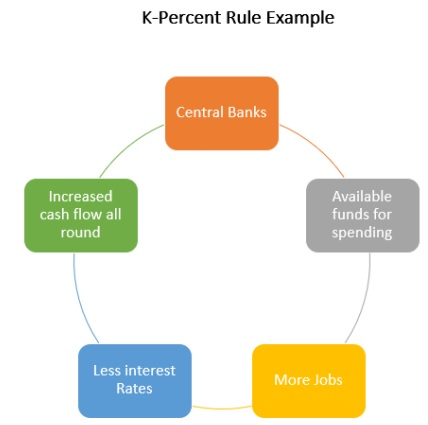
 Data Structure
Data Structure Networking
Networking RDBMS
RDBMS Operating System
Operating System Java
Java MS Excel
MS Excel iOS
iOS HTML
HTML CSS
CSS Android
Android Python
Python C Programming
C Programming C++
C++ C#
C# MongoDB
MongoDB MySQL
MySQL Javascript
Javascript PHP
PHP
- Selected Reading
- UPSC IAS Exams Notes
- Developer's Best Practices
- Questions and Answers
- Effective Resume Writing
- HR Interview Questions
- Computer Glossary
- Who is Who
What are K-Percent Rule and its advantages?
It was developed by economist and Nobel Prize winner Milton Friedman, and it is a monetary policy guideline that compels central banks to expand the money supply irrespective of the state of an economy's financial system. Friedman suggested that central banks should increase the amount of money in distribution in the economy by a certain percentage (known as the "k" variable) each year in order to keep inflation under control over the long run.
The K-percent rule proposed that the growth rate of money supply be fixed at the same rate as the growth rate of real GDP. Generally speaking, GDP growth varies between 1 percent and 4 percent each year on average.

Key Points Briefly
Milton Friedman proposed the K-percent rule in which he suggested that irrespective of the current economic fiscal policy, Government must increase its spending by K-percent.
This rule recommends that the money supply increases at a rate that is equal to the growth in the gross domestic product (GDP) every annum, as proposed by the K-Percent Rule.
If we look at historical averages, this would usually be in the region of 2-4 percent in the United States.
What is K-Percent Rule and How does It Work?
The central bank’ fundamental goal is to maintain the stability of an economy and to monitor growth rates in order to guarantee that the economy does not develop too fast or too slowly in the future.
Under the K-percent rule, Central banks increase the pace of expansion of money supply in the presence of a cyclically weak economy to increase the rate. This clearly indicated that the amount of capital in circulation is far greater than the value of economy itself.
There are times when central banks restrict and limit the massive growth of financial supply in well developed economy as it could result in inflation. Despite the negative impact, it is meant to act as a protective step and a safeguard for the country.
Meaning of the K-Percent Rule in the Real World
Friedman believed that banks were not the providers of stability but on the other hand, they were responsible for cyclic fluctuations. He suggested that growth in money supply could eventually reduce inflation. This was proposed to deal with commercial losses and fluctuations.
He urged everyone to use the K-percent rule to stabilize price level and to restrict the involvement of central banks from making broad sweeping monetary decisions. He argued against proving banks control as he believed that enabled them to take unreasonable decisions.
Due to the strongly held beliefs against central bank, K-percent rule does not allow banks to have any role when formulating monetary policies, which has prompted many economists to oppose the regulation. The policy does not allow making any changes, and therefore is ineffective in the short term.
Governments Role in Monetary Policy & K-percent Rule
Interest rates and monetary supply are managed as part of the broad ranging macroeconomic policy. The central banks and the Government implements many demand-side policies to ensure proper growth and stability. Central banks uses vast amount of financial tools like credit control policy, bank rate policy among others to achieve their monetary policy.
Fluctuations are natural outcome as a result of using such financial instruments and the changes in the interest rate. The role of the authority is to conduct an expansionary or contractionary role with the policy.
Making monetary policies gets more complex as it becomes increasingly essential to preserve equilibrium among different economic factors. In order to create successful policies, monetary rules such as the K-percent rule are utilized in conjunction with a tradeoff between economic factors.

